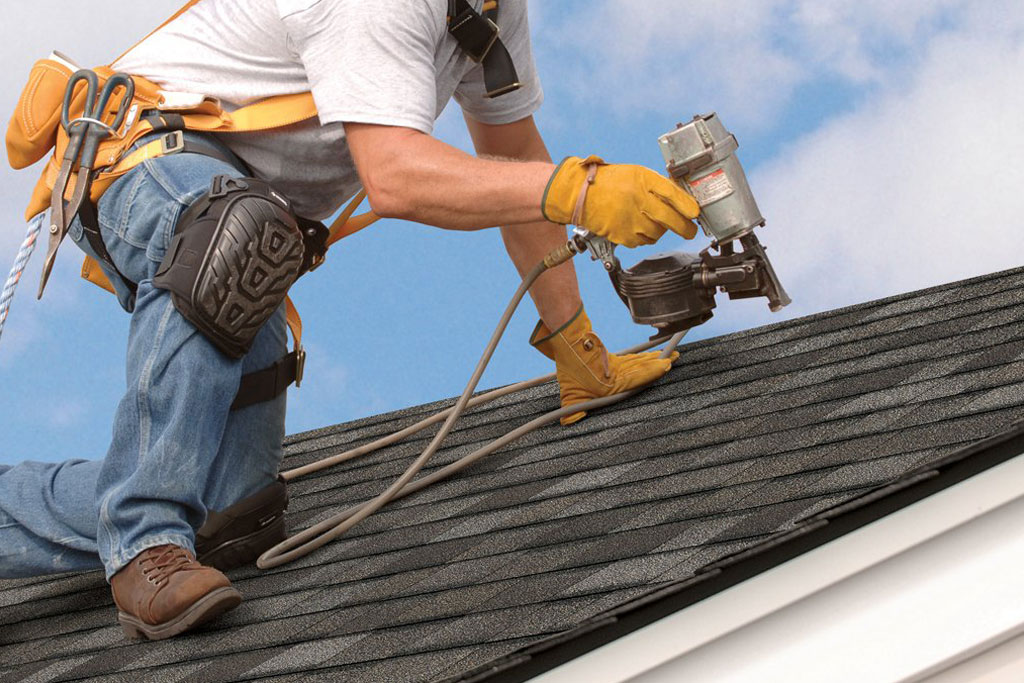Exactly How to Determine Typical Roof Covering Troubles and Their Solutions
When it comes to preserving your roof covering, identifying usual troubles early can save you time and cash. You might observe indications like water discolorations, missing out on shingles, or also moss development.
Indications of Roof Covering Leaks and Exactly How to Repair Them
A dripping roofing system can transform your home into a migraine if not resolved quickly. You may discover water stains on your ceiling or walls, which typically indicate a leak. If you see peeling paint or mold and mildew development, it's a sign that wetness is entraped. Furthermore, pay attention for dripping audios throughout rain; that's a clear warning.
To deal with these problems, begin by finding the source of the leakage. Check your attic room for signs of moisture or water entrance. For more substantial damage, you might require to replace roof shingles or even repair flashing.
Identifying Missing or Damaged Shingles
When examining your roof covering, seek any type of missing out on or damaged roof shingles that could lead to larger issues. A visual inspection can expose indications of water damages, which might suggest that it's time to repair or replace those shingles. Attending to these issues early can save you money and time in the long run.
Visual Examination Techniques
To effectively recognize missing out on or harmed roof shingles, begin by conducting a thorough aesthetic inspection of your roofing. Get hold of a set of binoculars for a more detailed look, or utilize a ladder if you fit. Check for any type of roof shingles that are crinkled, cracked, or totally missing. Pay special focus to locations around chimneys, valleys, and vents, as these areas are prone to damage. Try to find granules in your seamless gutters or on the ground, which shows wear. If you notice any kind of staining or irregular surface areas, that can indicate a problem. Do not forget to inspect the edges of your roofing; loosened or busted roof shingles here can lead to bigger concerns. Regular assessments can aid maintain your roofing system's stability.
Signs of Water Damages
While examining your roofing system for missing out on or harmed shingles, look for indicators of water damages that can suggest underlying concerns. In addition, evaluate the sides of your roof and around smokeshafts for any kind of signs of rot or mold, which can hint at long term wetness exposure. Resolving these signs early can protect against a lot more comprehensive damages and costly fixings down the line, guaranteeing your home continues to be safeguarded.
Repair or Replace Alternatives

If you uncover missing or damaged shingles during your roof covering assessment, you'll need to make a decision whether to repair or replace them. The best choice typically depends upon the degree of the damages. A repair work may be all you require if only a couple of roof shingles are impacted and the remainder of your roofing system is in good problem. Restore those areas, and you can expand your roofing's life.
A brand-new roof can boost your home's visual allure and energy effectiveness. Constantly take into consideration the age of your roofing and your budget plan when making this choice.
Recognizing Drooping Roofings and Their Causes
Identifying a sagging roofing is vital because it typically signifies underlying architectural concerns that need prompt interest. Begin by inspecting the roofing system for noticeable indicators of sagging, like a bowing facility or drooping eaves.

You must also examine for indications of timber rot, which can deteriorate the structure even more. If you suspect drooping, it's crucial to consult a roof professional. Early intervention can stop expensive repair services and ensure the safety and security of your home. Do not wait; attending to the concern without delay can shield your financial investment and your peace of mind.
The Dangers of Moss and Algae Growth
Moss and algae growth on your roofing system isn't simply an eye sore; it can present significant carcinogen and lead to architectural damage gradually. These organisms can jeopardize your roof covering's stability and create a reproduction ground for unsafe spores if left untreated. Let's discover exactly how to avoid and treat this problem efficiently
Health And Wellness Hazards of Growth
While you might appreciate the all-natural elegance of moss and algae on your roofing system, it's important to understand the potential health threats they pose. It's crucial to keep your roof covering clear of these developments to maintain a healthy living environment. Don't ignore the value of a tidy roofing!
Structural Damages Dangers
If you allow moss and algae thrive on your roof, you might be setting the phase for major structural damages. Over time, this wetness can deteriorate your roofing system's architectural integrity, making it extra prone to leakages and other issues. Ignoring these signs not just risks your roofing yet likewise the whole framework of your home.
Avoidance and Treatment Techniques
Overlooking moss and algae can bring about significant concerns, yet taking safety nets and treating any type of existing development can secure your roof covering. Start by regularly cleansing your roof to eliminate particles and moisture, as this produces an atmosphere for growth. Use a combination of water and bleach to gently scrub the impacted locations if you observe moss or algae. For avoidance, take into consideration installing zinc or copper strips along the ridge of your roof covering; these steels prevent development as rainfall cleans over them. In addition, ensure your roofing system has appropriate ventilation to minimize dampness build-up. By remaining positive and resolving these problems immediately, you can expand your roof's life-span and keep its integrity, saving you expensive repair work down the line.
Recognizing Roof Covering Ventilation Issues
Appropriate roofing system ventilation is necessary for preserving the integrity of your home, as original site it assists regulate temperature level and wetness levels in the attic. Without sufficient ventilation, you might face major problems like mold growth, wood rot, and enhanced power expenses. Examine your roofing for indications of poor ventilation, such as too much heat in the attic during hot months or condensation developing on rafters.
You ought to additionally seek unequal snow melting in winter, suggesting trapped heat. If you discover any one of these signs, it's time to assess your air flow system. Make certain you have a balanced intake and exhaust system, enabling fresh air in and stale air out.
You may need to include ridge vents, soffit vents, or gable vents to enhance air movement. Regular maintenance and monitoring can protect against expensive fixings down the line, so don't forget this crucial facet of your roof.

How to Place Roof Flashing Problems
Maintaining great air flow is simply one component pantile 2000 of a well-functioning roof system; roofing system blinking plays a vital duty in maintaining your home safe from water damages. To identify flashing problems, beginning by examining the areas where different roofing areas satisfy, like valleys, vents, and smokeshafts.
Likewise, analyze the flashing for any type of indications of bending or imbalance; these issues can endanger its performance. If you notice any of these indicators, it's essential to resolve them without delay to prevent expensive damage.
The Significance of Normal Roofing Inspections
While it's easy to overlook, regular roofing examinations are vital for protecting the integrity of your home. By arranging these assessments, you can catch potential concerns before they intensify into costly repair services. Examiners will certainly recognize troubles like missing out on tiles, leakages, or put on around flashing that you might not see from the ground.
You'll also take advantage of assurance, understanding your roof is in good condition. Your roofing shields whatever underneath it, from your family members to your belongings. Normal assessments can prolong your roof's life expectancy and enhance its efficiency, conserving you money in the long run.
Make it a practice to examine your roof covering at the very least two times a year and after substantial weather occasions. Remaining proactive about roof covering maintenance assurances you attend to small issues before they become significant frustrations. So, don't wait until it's far too late-- schedule your roofing system evaluation today!
Regularly Asked Concerns
How Often Should I Set Up Professional Roof Covering Examinations?
You must schedule specialist roof covering evaluations a minimum of once a year. Nevertheless, after severe climate events, it's smart to have an evaluation faster. Regular checks aid catch prospective concerns before they escalate into expensive repairs.
Can I Fix My Roofing Myself, or Should I Hire a Specialist?
You can try roof repairs yourself if you're confident and have the right tools, yet working with a contractor ensures expert quality and safety. Evaluate your abilities and the project's complexity before choosing.
What Are the Signs I Required a New Roofing System?
You'll recognize you require a new roofing system when you detect significant leakages, missing roof shingles, comprehensive granule loss, or sagging areas. It's time to ponder substitute choices. if your roof covering's age goes beyond 20 years.
Just How Much Does Roof Covering Fixing Usually Price?
Roof covering repair work costs generally vary from $300 to $1,500, depending on the damages and materials needed. You'll intend to get numerous quotes to assure you're making the most effective decision web link for your spending plan.
What Products Are Best for Roof in My Climate?
You need to think about materials like asphalt tiles for moderate environments, steel for durability, and clay floor tiles in hot areas. roofing chesterfield mo. Each choice has special advantages, so think of your environment's certain requirements and your home's design
When examining your roofing system, look for any missing out on or harmed shingles that can lead to larger troubles.To efficiently identify missing out on or harmed tiles, start by performing a comprehensive visual inspection of your roofing system.While checking your roof for missing out on or harmed tiles, look for indicators of water damage that can suggest underlying problems.If you discover missing out on or damaged shingles throughout your roof inspection, you'll need to decide whether to repair or change them.Preserving excellent air flow is just one part of a well-functioning roofing system; roof covering blinking plays an important duty in keeping your home safe from water damages.